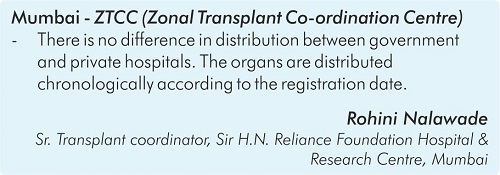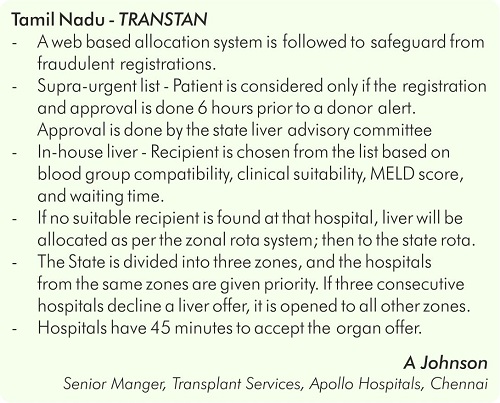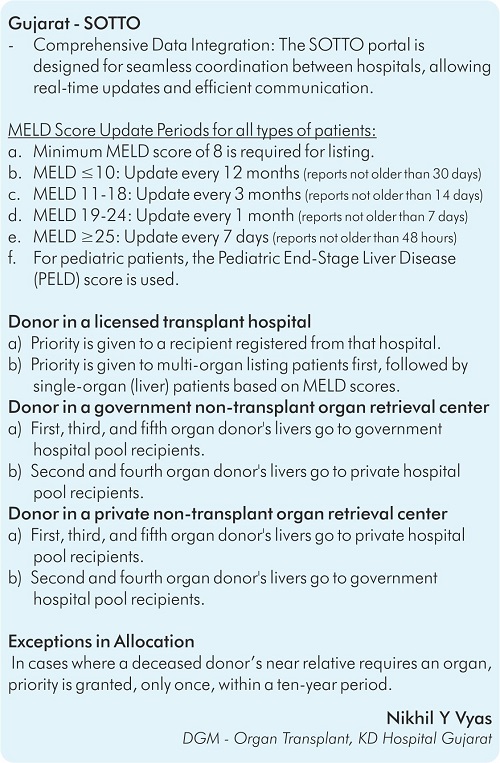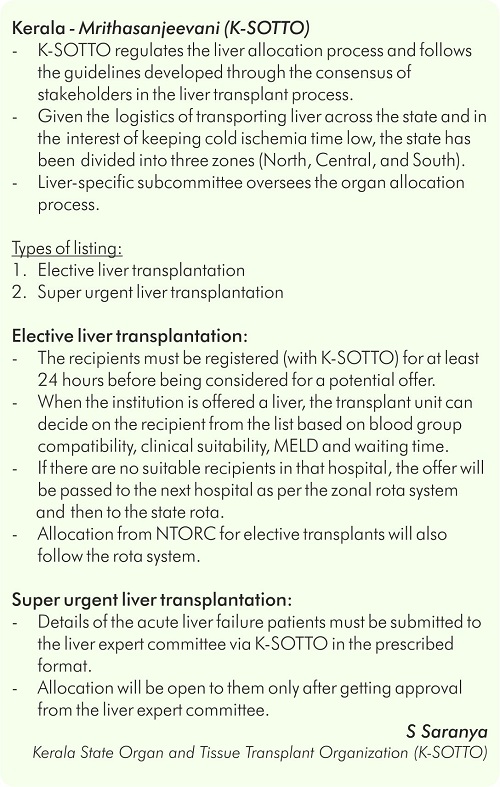Home / Newsletters / ITN 74 / Subscribe
Allocation Policies - Liver Allocation Practices in Different States Across India
Hemal Kanvinde
Indian Transplant Newsletter. 2024 Oct-Dec; 23(4):p10-11
Print ISSN 0972 - 1568
PDF
In the recent years, liver transplantation has gained momentum in many states of India. Across the country, 4,491 liver transplants were carried out in 2023, of which 840 (18.7%) involved deceased donors. The National Organ Tissue Transplant Organization (NOTTO) has set guidelines for patient listing and liver allocation. Even though these guidelines have been adopted, there are some variations and state-specific protocols which are seen.
NOTTO guidelines for allocation of deceased donor liver
(www.notto.mohfw.gov.in)
Recipient Registration and Listing
- Patient is to be registered by the concerned hospital
- Patient should be registered only in one hospital
- Liver Advisory Committee will approve the registration and urgency criteria
- Standard listing
a. Patients with a MELD (Model for End-stage Liver Disease) score greater than 15
b. Patients with cirrhosis of liver with hepato-cellular carcinoma should be with-in UCSF criteria
- Super-urgent listing
a. Primary Non-Function (PNF) of liver allograft
b. Living liver donor who develops life threatening liver failure
c. Early Hepatic Artery Thrombosis (HAT) requiring re-transplant
d. Fulminant Hepatic Failure (FHF) meeting the King's College Hospital criteria
- Contraindications to listing for liver transplantation
a. MELD Score <15
b. Severe cardiac or pulmonary disease, who is unfit for general anaesthesia
c. AIDS
d. Hepatocellular carcinoma beyond UCSF criteria
e. Uncontrolled sepsis
f. Intrahepatic Cholangiocarcinoma
g. Extra-hepatic malignancy transplant
- Status of the listed patient must be updated monthly.
For Super-urgent patients, status update is required daily.
Allocation Principles
- Sequence of allocation of organs shall be in following order:
State list-Regional List-National List
- Livers from pediatric donors (<16 years) are prioritized for
pediatric recipients; if none, then adults.
- blood group liver is given first to O recipients, then to others
- Other than O blood group (A, B and AB), liver will be preferably
allocated to the same group, otherwise to AB
Allocation Algorithm
Check Blood Group & age of donor
Allocation will be done based on the medical urgency
- Super-urgent list
- Simultaneous multi-organ transplant based on waiting time list
- Single organ (liver) transplant
Types of donor hospitals
- Donation from a Transplant Hospital - Liver will be allocated to
local transplant hospital
- Donation from a NTORC - Liver will go to the common pool and
allocated as per the rota
Liver retrieved from a government hospital
- Government hospitals other than Army Hospital R&R, by rota
- Army Hospital R&R, Delhi
- Private hospitals as per the rota
Liver retrieved from a private hospital
- Rota of private hospitals
- Government hospitals other than Army Hospital R&R as per rota
- Army Hospital R& R, Delhi





Available at:
https://www.itnnews.co.in/indian-transplant-newsletter/issue74/Allocation-Policies-Liver-Allocation-Practices-in-Different-States-Across-India-1363.htm
- Copyright © 2025. Published by MOHAN Foundation
